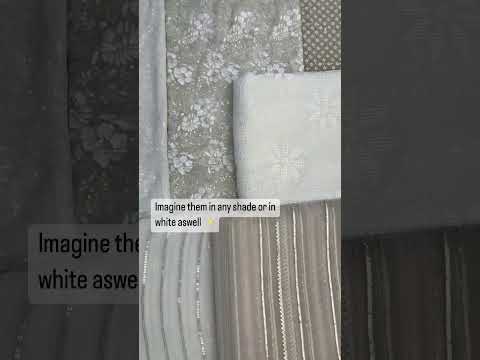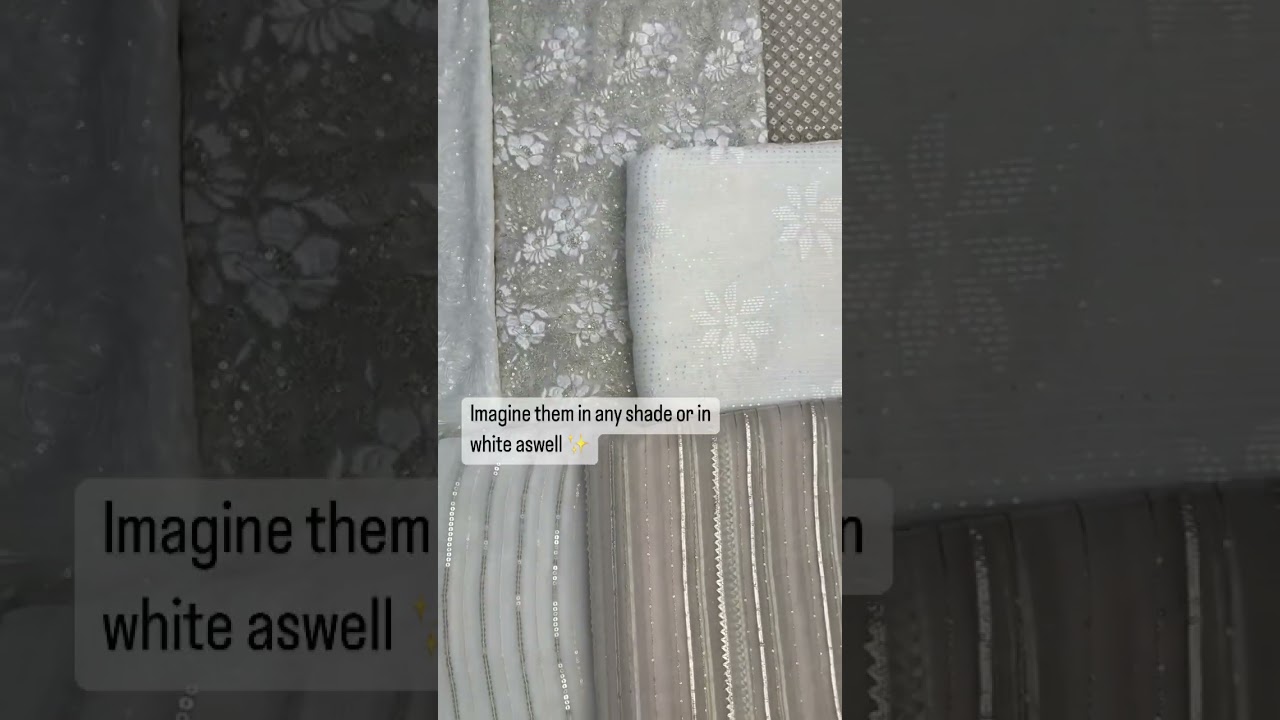Discover the exquisite artistry of embroidered fabric, a true testament to the beauty and craftsmanship of traditional textiles. Delicately crafted by skilled artisans, this embroidered fabric combines intricate designs with high-quality materials, resulting in a piece that is both visually stunning and rich in cultural heritage. Each stitch is meticulously placed, creating a mesmerizing tapestry of patterns and motifs that captivate the senses. With its embroidered details, this fabric elevates any garment or home decor item, adding a touch of elegance and sophistication. Whether adorning a dress, a pillowcase, or a wall hanging, the embroidery brings a sense of luxury and refinement to any setting. Immerse yourself in the world of embroidered fabric and embrace the timeless beauty that it encompasses. From intricate floral patterns to geometric designs, the possibilities are endless, allowing you to express your individuality and unique sense of style. With its rich history and exceptional craftsmanship, this embroidered fabric is not only a fashion statement but also a cherished piece of art that will be treasured for generations to come. Experience the allure of embroidered fabric and indulge in its remarkable beauty.

The Art of Embroidered Fabric: A Timeless Craft
Embroidery has been an integral part of human culture for centuries. This ancient art form involves decorating fabric with intricate needlework, creating stunning designs that add beauty and elegance to any garment or textile. From delicate flowers to elaborate patterns, embroidered fabric has stood the test of time as a symbol of craftsmanship and creativity.
The Origins of Embroidery
Embroidery can be traced back to ancient civilizations, with evidence of its existence found in ancient Egyptian tombs and Chinese artifacts dating back to 5th century BC. It was initially used to embellish religious garments and ceremonial textiles, showcasing the wealth and status of the wearer. Over time, embroidery techniques evolved and spread across different cultures, resulting in a rich tapestry of diverse styles and traditions.
The Intricate Techniques
Embroidery encompasses a wide range of techniques, each requiring precision and skill. One of the most common techniques is hand embroidery, where intricate designs are stitched onto fabric using a needle and thread. This labor-intensive process allows for meticulous attention to detail and a unique, handcrafted look. Another popular technique is machine embroidery, which utilizes computerized machines to create intricate designs quickly and accurately.
Additionally, embroidery stitches play a crucial role in creating beautiful patterns. Some commonly used stitches include the satin stitch, which is ideal for filling large areas with solid colors, and the chain stitch, which creates a textured and decorative line. The choice of stitch depends on the desired effect and the intricacy of the design.
The Versatility of Embroidered Fabric
Embroidered fabric is incredibly versatile, making it suitable for a wide range of applications. It can be found adorning clothing, such as wedding dresses, evening gowns, and traditional costumes. Embroidered fabrics also lend themselves well to home decor, with cushions, curtains, and table linens being popular choices. Furthermore, embroidered patches and badges are often used to personalize garments or add branding to accessories.
The versatility of embroidered fabric extends beyond clothing and home decor. It has also become a popular medium for contemporary art, with artists using embroidery to create stunning pieces that push the boundaries of traditional techniques. These artworks often explore themes of identity, culture, and social commentary, adding a unique dimension to the art world.
The Cultural Significance of Embroidered Fabric
Embroidery has deep cultural significance in many parts of the world. It serves as a visual representation of a community’s history, traditions, and identity. In some cultures, specific embroidery motifs hold symbolic meanings, conveying messages of love, protection, or spirituality. For example, the traditional Palestinian embroidery known as tatreez features geometric patterns that tell stories of resistance and resilience.
Furthermore, embroidery has been used as a means of economic empowerment for women in various societies. In many regions, embroidery skills have been passed down through generations, providing women with a source of income and independence. Organizations and cooperatives have also been established to support and promote the work of these talented artisans.
Caring for Embroidered Fabric
Proper care is essential to preserve the beauty and longevity of embroidered fabric. Hand-washing is often recommended, using mild detergent and cold water. It is important to avoid wringing or rubbing the embroidered areas to prevent damage. After washing, gently reshape the fabric and air-dry it away from direct sunlight. Ironing should be done on the reverse side or with a pressing cloth to protect the delicate embroidery.
In conclusion, embroidered fabric is a timeless craft that has captivated people for centuries. From its ancient origins to its versatile applications, embroidery continues to be a cherished art form celebrated for its beauty and cultural significance. Whether adorning clothing, enhancing home decor, or pushing the boundaries of contemporary art, embroidered fabric will always be an exquisite testament to the skill and creativity of artisans around the world.
“Dyeable Embroidered Fabrics: Unleashing Creative Potential at SourceItRight”
List of Embroidered Fabric
Embroidered Fabric
| Fabric Type | Origin | Embroidery Style | Notable Features |
|---|---|---|---|
| Silk | China | Chinese Knots | Exquisite craftsmanship, intricate designs, vibrant colors |
| Velvet | Italy | Floral Embroidery | Soft texture, three-dimensional appearance, rich color saturation |
| Cotton | India | Kantha Stitch | Rustic charm, running stitch patterns, recycled fabric |
| Linen | Egypt | Crewel Embroidery | Traditional motifs, woolen thread, raised surface |
| Organza | France | French Knots | Sheer and delicate, elegant designs, intricate details |
Embroidered fabric is a true testament to the artistry and skill of the craftsmen who create it. Each fabric type carries its unique characteristics, originating from different regions and boasting distinct embroidery styles. Let’s explore some fascinating information about embroidered fabric through this table.
Silk, originating from China, showcases the mastery of the Chinese Knots embroidery style. Renowned for its exquisite craftsmanship, embroidered silk fabric displays intricate designs and vibrant colors, making it a symbol of luxury and elegance.
Velvet, hailing from Italy, is adorned with floral embroidery. This fabric type’s soft texture lends itself perfectly to the three-dimensional appearance achieved through embroidery, resulting in a visually stunning and tactile experience. The rich color saturation of velvet makes it an ideal choice for creating intricate embroidered motifs.
Cotton, with its origins in India, features the Kantha Stitch embroidery style. This fabric’s charm lies in its rustic appeal, characterized by running stitch patterns. Notably, cotton used for Kantha embroidery is often recycled, adding a touch of sustainability to its already impressive aesthetic.
Linen, originating from Egypt, showcases the timeless beauty of Crewel Embroidery. Traditional motifs come to life on linen fabric with the use of woolen thread, creating a raised surface that adds depth and richness to the embroidery. Linen’s natural properties make it an excellent canvas for this intricate technique.
Organza, a fabric associated with France, is adorned with the delicate art of French Knots embroidery. Its sheer and lightweight nature adds to the elegance of the intricate designs created through this embroidery style. French Knots embroidery on organza fabric is renowned for its attention to detail and its ability to capture intricate patterns.
Embroidered fabric is a testament to the rich history and cultural heritage of various regions. It not only enhances the beauty of garments but also serves as a medium through which stories, traditions, and artistry are conveyed.

